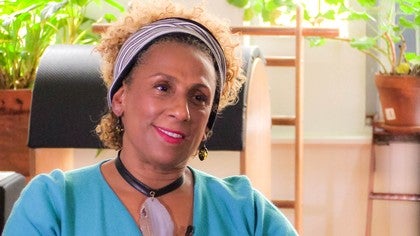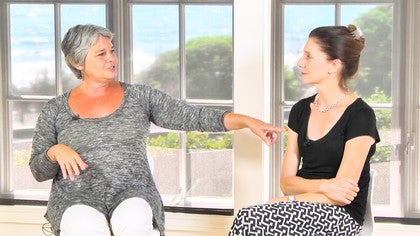Description
About This Video
Transcript
Read Full Transcript
Hi, my name is Sarita Allen. I was a student of Kathy grants my whole life. I had the privilege of working with Alvin Ailey and having him Cray graph 10 ballets for me. Um, I was fortunate enough to travel the world again for 20 years with Alvin Ailey American dance theater. I'm now a teacher of Pele's. I teach at, um, the television studio home box office. I teach at Alvin Ailey and I teach at a studio in New York city called D L fit PyLadies Walden studio. I'm also a choreographer, et cetera. This is the mid seventies, and I was 15 years old, straight, had not graduated high school, got a scholarship to study in New York city with the newly formed dance theater of Harlem, which was the first ballet company for black dancers only.
So you can imagine. I was very, very excited, had no family, had no friends. Uh, my family put me in a, um, st Mary's. It was this, um, convent. So anyway, first day of class, very excited. I'd find myself on the floor with the rest of the students who had come from various places, Indiana, Wyoming. And here we are and we're on the floor pumping our arms. Seeing Mary had a little lamp looking at each other like, where are we?
I think we're in the wrong place. We came here to do ballet and the teacher's name for us, it was Mrs. Grant and we had no idea what we were doing in those days. There was a very much difference between ballet dancers, modern dancers. I mean the most ballet dancers who were on the floor was to perhaps stretch at the end of the beginning of the class. And that was about it. She had a saying, Mary had a little lamb blowing whistles, blowing bubbles up to the ceiling. I mean this was completely foreign. We thought, what is this? Is this cup?
Some kind of weird thing. We really came here to do ballet and that was my first, um, meeting with Kathy grant. Well, Kathy, when she was very young, she just had this passion and by all accounts she was gifted racism being one of them. She wasn't allowed to dance. So therefore she lived through us and not only the black dancers, she loved dancing in general and she laughed. She loved ballet. She loved modern, any type of dancing. She just had a passion for as she did all types of arts, visual arts, music, arts.
So she had invested interest in this because the fact that she wasn't allowed to do something, she was going to make sure that we only not did it, but did it better than anybody else. I never got to see her buy all the clowns. They said she was phenomenal, like that extra gift that, you know, some people be technically gifted, but she had something else because that she was so gorgeous and she was so technical and so beautiful. But because she was not allowed to do classical ballet, she says, well, I'm going to dance anyway. I'm gonna. I'm going to find some, I have to move. And so like a lot of black performance during the time she went to Europe, she goes to fin Baker, a lot of jazz musicians. He found the acceptance in Europe.
So she went to Europe and had an amazing career. She lived in Spain, performed in Spain, in Europe and Bay route, and had an amazing, amazing career, but doing cabaret dancing, I mean very technical cabaret density, but it was not in an opera house. During one of those trips in Europe, she had one of her partners, her main partner dropped her and on her knee. And it became, it was impossible in those days, of course that did not have orthoscopic surgery. So if you had knee surgery, that was pretty much done. So she found her way to mr palati and the rest is history. She just became a NAMD with this man and his work. And during those days they have, um, the government, I think they might still do, they have, um, a program where you could become trained in something to have a new profession.
And since dance was her profession, she no longer could do it. Mr [inaudible] not only taught her to help her get better, but trained her as a teacher. So she was actually certified to be a teacher from him. She would say, the minute you come in, stop dancing, because dancers, we would always do something like we were doing the teaser and we would reach it. She goes, no drama, stop dancing, cut the dancing, no pointed feet. In fact, she would always say normal people, normal people, lay people did Palladio's a lot of times better because they didn't have all these affectations. Once you came in the studio you, she was an equal opportunity and that's one of the things that made her great. She trained a grandmother from the Bronx with the same care as she did the principal dancer of New York city ballet. There was no difference. Her approach, you do the work and in that instance she was amazing because she did not demand any less from somebody who wasn't a dancer.
She had the most respect from them, of course, within their framework, but she trained them the same with the same attention to detail. She didn't say, Oh well she's just, she doesn't have to do it that good. Oh, that's good enough. No, we were all equal. There was, there was no difference in that sense. She gave us all her best and demanded the best from all of us. No less. If you are 82, she didn't care. No, you're going to do it. You're going to do it. No, you could do better than that. You know, she didn't say, Oh, that's good for an 82 year old. No. She say, look at me.
I'm whatever I age she was and I'm going to do it so you can do it too. So that's what made her, I think very, very special. She demanded the same from everybody and that was excellent. And she didn't just be little people because they, you know, they were heavier, whatever they were. Well, you know, I can't even actually remember how I ended up back there after the years later at dance theater of Harlem. Like that part is a little bit of a blur. Um, I think I was at the Ailey company at that point and I remember having, or just at the very beginning, maybe I didn't even join yet.
I remember coming back from Seattle when I graduated and I had torn my cartilage when I was in Seattle. But I also had, I think the dance theater of Harlem had invited me to come back when I graduated to be in, not in the company, take company class. My knee was not healed, but of course I wasn't going to say that. You know, you're 16 years old, you're going to, you're invited to come to the company. So I think I was good enough, I could walk around and I hit it. So therefore the pain became so bad that I couldn't have it once I get to New York. So then I went to Kathy and she, you know, that of course led me to one of the first doctors who was in long Island city who was performing orthoscopic surgery. And so therefore then after I had that, and then she, you know, got me back to where I was able to actually dance.
So right at the beginning I came with an injury, very bad injury. What's gonna make it worse? Had I continued dancing? So that's why I initially came to Bendel's for that. But those, first of all, you paid $10 for a 10 10 class card, $10 and even throughout her life she kept her prices crazy because she knew the dancers, even dancers in good companies really couldn't afford what private pilot is really cost. I think at her highest, I think right before she passed, I believe the highest session was $40 it was interesting because at Bendel's she was always around the society ladies and they were always asking her to come to their home, to be her personal trainer at for like a gazillion dollars, I don't know, like $400 an hour even back then. And she was like, no, I don't think so. She never, they were always asking her and she, first of all, she said, I don't think I could take that. I'm not that type of person because I'm not going to kowtow to them. I'm going to give them the truth and I don't want to be away from you all.
So that's how passionate she was and working with the dancers or the artists and whoever else was there. No, I'm not going to get rich doing this and you can pay here. You need me again, this is a long time ago, but there were very few times when we were by ourselves perhaps really early in the morning cause I remember and this was one of her strategies of helping us become, you know, not only trained in Palladio's but full people. She would have some of the wild people, myself being included come to early morning classes. So our appointments were before the store opened. So we would come in the service entrance like at 7:00 AM so would force us to go to bed, would force us to get up early. But it was also afforded us to be able to go to class, company class, which was at 10 o'clock you know like most people, their hours would, these are my hours. I can't come because I'm in class. She made it.
Most of the time, a normal day there would be a pianist who was there because their shoulder was bad or their wrist and they couldn't play concerts anymore. Or there would be an artist, say for example, I remember one artist who worked with big canvases and because if she was working with the big canvases with the one arm, her arm and her shoulders, she could no longer pay it. There would be an actor there. There was one young actor who was naturally not very physically fit, but he got this big movie role and he couldn't run. So she was helping him get to the point where he could act as like a child and just run. And then there'll be a principal dancer for New York city ballet. There was a lot of us at least.
Usually there was at least three or four people there at the same time. And we worked with each other. Kathy was one of the most creative people that I've ever met. Um, she was also honestly hungry. She continued to do continuing education on herself.
I remember she always had hundreds of tear sheets, no matter how smart and how gifted she was. She was always looking in books. She was always teaching herself anatomy. She was looking for pictures of um, like an animal or something that would spark something in someone else. But mainly it's about her continuing education. She always had books, always had magazines and she would tear pictures out of, I don't know, we didn't have so many fitness magazines there, but there was something like she would take things sometime from Jane Fonda. Some people needed cardio. But anyway, she was always educating herself and that's one of the thing that I got from her. I'm always reading books. She says you have to keep current, you have to keep your mind and you have to keep finding different ways to get people to do the what you want them to do. That means education, education, education. Because everyone is so different.
I think one of the, there was so many things that I take from her. One of them is just looking at the individual themself and taking them as in there. I mean we're all different, but you really have to, even if they're doing the same exercise in order to have them do the same exercise properly, we all need different things, you know, so and then the safety of people, I mean she ingrained in us. These people are trusting you with their bodies so you can't play fast and hard. In fact, I was all, when I first started teaching, I had to lighten up a bit. I was so conservative with my teaching and I wanted them to be so perfect.
I would spend like a month on the head lift or a knee fold and I had no clients. So I've had to learn to kind of modify that because she wanted us to be so perfect that before we even got in the reformer, it could be like three months. So that doesn't really fly right now. But the respect for the human being, this respect for the body and making sure people were ready to do something, you just didn't throw exercise on people. You know, a lot of people come in and say, Oh, I'm strong. I've been doing Pilates for a long time and they really haven't and they could hurt themselves. So first and foremost, she would say safety of the body. You have to watch people's body, you have to watch them and make sure they're not hurt and no one ever got hurt in there. In her studio there was a lot of um, the, the method to her madness and as serious and as strict as she was, she also had a crazy sense of humor.
And what's interesting about enough, and this is something that I respect her, she wanted you to get it and it wasn't, she didn't treat you all right, you coming in, you just doing exercise session. All right, just push out for five and for more. Okay, that's good. Pull your tummy in. It wasn't anything like that. She wanted you to do it properly. Now we know a lot of people perhaps don't know in [inaudible] the neck is very sensitive and one of that doing the head lift properly is one of the hardest things you can do without causing tension. So she found all different creative ways and the breathing is one of the important tenants in pilot is proper breathing. I mean that something is very difficult. You have to learn.
So she found different ways to help us. I think the pinwheel was actually mr palati but she enhanced upon it so we would have pinwheels. So just holding a pinwheel in blowing in itself, if you are in an adult made you kind of feel whimsical because it's fun. It's a pinwheel, you're blowing a pinwheel for goodness sake. So you kind of focused on that and didn't really acknowledge that your abdominals were killing you cause you were blowing this pinwheel. But yet there was no tension in your life. You know, there was no tension.
I find when we're doing, and I just started rediscovering and adding, there was a famous exercise that she called the telephone sit-ups, which is very funny now. In the beginning you had to say, my name is Serita diet Allen. I live at 64 and she would say sing it. And when I say sing first, when I give people that, now they look at me when I'm crazy, but then they notice, Oh wow, I'm doing it, but I'm not, there's no tension in my neck. So there was a few things, there was a few reasons. It kept the breadth. Okay, open the breathing open. It kept your relax, but it slowed you down. Because if you had all these things to say before you hit the ground, you had to slow down. What's interesting now is now we have cell phone, we have an email. We didn't have all these things before.
We just had a telephone number. So sometimes I'll add an email and the, you know, and the cell phone on top of it. So they really have to go slow, you know? But they, it really helps. It keeps attention out. It slows them down and it's fun. All of a sudden, you know, you have a room full of people saying, my name is, and they start to smile. They get less tense. Well. What was interesting about when she was training the dancers, especially very, very successful dancers, that she did not acknowledge that, so it kept you humble. She would also come to all of our performances so she could see what she needed to work on, what we needed to work on. You could have a standing ovation, the best review in the New York times.
The next morning you're going in there and she goes, go over there. Whole panini shoulder down, hold. So goes Serena, see that foot, fix that foot. She was training us even when we didn't think we were being trained, because if you see someone else, you have a better sense of yourself. So when we were all together, we all worked with one another. We never even, there was three people. I'd never just stayed by myself.
If I knew something, she would say, Oh, teach so-and-so the stomach massage, or she was working with someone. She would say, Robert, go look at her. She's straight. She would train his all the time. Our I and she would say, look at that person. Now, what's interesting, what I find now, because I'm working with very, very famous dancers to the naked eye, they look perfect. You come in there, principal dancers, they're not going to be obviously crooked. They're not going to be fat because they're do, they're perfect. They're perfect specimens. So how would you, how would you look at them? How would you find them? Because obviously to the trained eye, they look perfect. They're flawless specimens. So they, she trains you to find, wow, I didn't see that.
We would look at people all the time. And she says, look at them. Are they straight to the naked eye? They were. She goes, no, look at this. And you're like, Hm. Yeah. Or you have to find their imbalances inside. So what's different about working with or perfect athletes to the naked eye? They look perfect, but you also don't want to, Cal touted them either and waste their time and you know, it's easy.
So I find myself being very, I'm impressed by the athletes because they do something and they're like gorgeous. But you can't say to them, Oh my God, that's fabulous. It's not going to help them. They already know they're fabulous. They're not coming to you to be able to do a perfect thing and look fabulous. They're there. They're coming to you either to help them continue their career out of an injury, telling them they're fabulous is not going to help them.
So you almost have to have a poker face and not let their perfection or seeming perfection blind you. You know, dancers, she would always, if and she trained as differently. If you were in the middle of a season, you didn't do very hard things because she knew you were being physically taxed, so you did things. She knew what you were going to do. If you were working on a ballot that you had to do many married, pier, West, she would focus on your balance. If you had to do something that involved a lot of flexibility, then you would do that. You would do back strengthening things, so you would last her her. Another thing she would focuses on if you want to last, you have to get strong. So if you had a flexible back, the last thing is she's going to give you is a flexible back. You know, I've young people even Jimnez coming in and their backs are just crazy flexible.
They're hyper mobile. That's why they're good in gymnast, but you don't give them back things you don't have. You do the opposite. You train with, they're not good at and you have to find those good things because they're amazing athletes. So it's up to you define their imbalances, which can be very subtle and they're inside because everyone, no matter how good they are, has something to work on. Their imbalances aren't as obvious. She taught us without thinking, Oh, we're being a teacher. She taught us. We all had to help each other.
So as peop as teachers because, but by seeing somebody else, then you could see it in yourself. So that was part of her teaching with her not just doing it and you having to know it. Also, like a lot of things have changed a lot in terms of changing the Springs that she was adamant about. You have to know the Springs and when she would catch you change, you don't change your Springs, you have to do it. Now I have a lot of high powered people now. They don't really want to do that and they don't want to remember and I, I used to fight them on that. I said, you have to and they're seeing, sorry.
You know what, I'm having these, you know their general counsel for Johnson Johnson, she says, you know how many lawsuits they have? Sorry, I just can't remember this. And then I had to all of a sudden I'm thinking again, there's a change. I was different. I, it was my profession. I had to do it now. I had no clients. If I was just doing a head lift for a year, you know, now there was two things. There was different.
Like when she would have you sometimes help if she knew that you were, you know, in between jobs or something and she would say, come and help me. She wouldn't end, but she wouldn't say it. She wouldn't say, Oh, I know you're low on funds, wanted to help me. She'd say, Oh, I need help. Can you come in? So that would be different. She would say help her do this. Now when you're learning, look at them and she would say different things, how to work with certain people and and think about which images is going to help them. Like she was big on images. Like mr Plata says images are a big part of it so you have to find, she was stressed. You have to find the images going to turn that person on.
Every image doesn't work for somebody else. You have to find the image that they're going to respond to. But there was another thing I want to say, I don't know if it's, I think it's important that I think that I've taken from her that I think is different from a lot of people is her inventory. Her initial consultation lasted a long time. Like she would talk to you for hours and most people, you know, they fill out the form and they go email doctor and I see a lot of teachers, they don't even look at that. Her, her again.
When somebody would come in and then she would keep asking questions, remember? And they would go, Oh yeah, I forgot about that. I forgot about that. I forgot that I fell out of a tree. I forgot I injured this half all African. I broke my hand. So all of this will come into play. And the keeping of records, she would also keep each extensive records of what she did each session with the people when she introduced a new exercise and with Springs that they, she, you know, she wrote, I don't know too many people that do that for each session will, when I came to New York, I was 15. We had no family here, no even far relatives and cousins. And Kathy was the first person that I met. Really.
So she became my surrogate mom along with the person who pretty much gave me my career. You know, um, there was, at one point I was in Israel and I fell off of a trapeze. I had a brain concussion, brain edema lost the hearing in my ear. So of course we know hearing is balance. So they said, of course you would never dance again because you, you can't hear. Your balance is off. I had 15 more years of traveling the world because of Cathay.
So what was interesting about her is that not only she helped me physically or not just myself, all of us physically get well, but in doing this, I believe she gave me my career. Because when you find, when you're dancing from the inside, it becomes a more profound, even if you're not acting. So I love this. I'm recent right now I'm in the process of working with young dancers from the Joffrey ballet and teaching them that this is your instrument. So how exciting. So it takes it when you're in ballet class in your onstage, it takes it above. Oh, please. I hope I find my balance. And you're just praying is you know your instruments so well. Even when you're falling off balance, you know, okay, I gotta pull in here, tighten the zip this up. And you have control, which gives you freedom when you're on stage, when you're so in control of your instrument. If you go, if you fall off, you're gonna fall up, but you're not just so, Oh my God, what's going to happen?
You are in control. So when she gave us was even more free than we love to dance, but then when you're on stage and you have this instrument, it would surprise us all the time. Every time I was on stage it was like driving a new car and after a session with her and then I would be on stage and I was like, woo God, where did that come? You would surprise yourself because you would be so fierce. You would be like, Oh my God, how did they do that? How do they do that? And then also again, dancing from the inside out you had, it was more profound if you lifted your arm from the center.
You had much more stage presence than resonance than just lifting your arm. So it was a lot of things. It gave you the artistry to have the career, not just the technical ability to have it because she forced you to do it from the inside out. She wouldn't, whenever we would do something like that, she says, no, that's phony. That's drama. Don't dance is from the inside out. And if you live from there, you have it. Just that alone, even if you didn't make a story for your, your character, you had the residents. So it was pretty profound what she gave me. So, uh, you know, I owe her everything. So how do you wish her work and legacy to be remembered and is there a certain aspect of Kathy's work that you wish to be pre preserved? Above all, there's so much, so many people.
What I would like people to remember most about Kathy is her integrity. She had the utmost for tech integrity. She would be the first one in the studio. She never phoned it in. And she respected each individual so much that she had a plan for each person. Like she always said, I created a monster, she would say in herself because her integrity was so good that she, I don't remember actually even in 30 years, her missing a day.
She never missed. It was crazy. She would be ill, but she never missed. She'd go, you all need me. You all need me. She would study and everybody saw her integrity. She cared. She cared about you getting better. She had an F, a vested interest and her use of the balls, her creativity. If you couldn't get something, if you couldn't understand and exercise, then one of the things that sparked her creativity is she tried anything until you got it. She would not give up until you got it. That was the thing.
She would say, all right, let's try this, Bob. No, that's not right. Let's try this ball. She would try in size ball until she got the right ball that fit in your legs to get your leg aligned. She would sometimes have five people. You hold the shoulder down, you hold this hip down, you hold. Okay, now go. And she would wait until you got that muscle. Sometimes you would wait five minutes because she know that's your knee. No, that's your shoulder. No weight. You have to feel it.
Just wait. Just find that. Just find it. Just find that.
Pilates Legacy Project: Discussions
Comments
You need to be a subscriber to post a comment.
Please Log In or Create an Account to start your free trial.
























